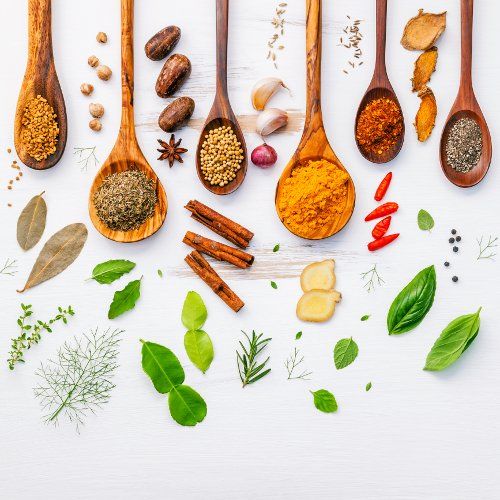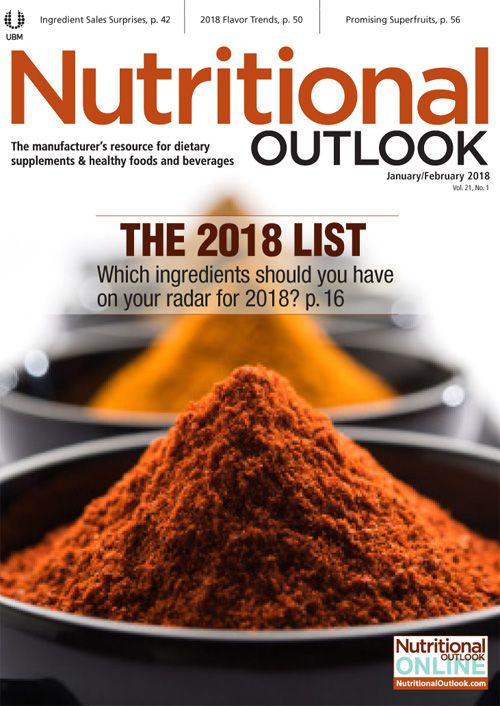2018 Flavor Trends for Food and Beverage
Top flavor houses and experts predict which flavor trends will be big in 2018.
Photo © Shutterstock.com/Kerdkanno

Taste is king when it comes to the success of a food or beverage. To tap into what’s hot and what’s not in the world of natural flavors, Nutritional Outlook once again turned to top flavor houses and experts for its annual forecast of which flavor trends will be big in the coming year.
Many of the experts Nutritional Outlook spoke with for this story agree that in 2018, authenticity and transparency will reign supreme, with flavor origins front and center. And, continuing a trend from years past, consumers will continue to demand new and exotic flavors, as well as upgraded but familiar flavors both savory and sweet. Soumya Nair, director, marketing insights, Kerry Ingredients (Beloit, WI), points to the company’s Flavor Forecast program, which predicts that this year, “authentic flavor experiences” from around the world, as well as continued demand for clean ingredients, will be major market drivers.
Greg Kaminski, executive research chef, Synergy Flavors (Wauconda, IL), agrees. According to Mintel, he says, “millennials are interested in different profiles, ethnic infusions, and the inferred flavors that are imparted by using specific preparation techniques.” Millennials are largely to credit for increased attention to ingredient origins, as well as for products that boast a cleaner label.
Nair adds that more than 75% of consumers are interested in learning more about the ingredients in products.” Clean-label, she continues, “has charged the food industry with a new challenge to meet consumer desire for organic, GMO-free, and artificial-free food and beverages.”
Authentically Delicious
According to Nair, an overarching trend that is likely to influence flavors of all kinds is authenticity for flavors from cuisines that consumers may not be familiar with. “The thirst for authentic experiences has seen a surge of unique flavors and blends that are true to the cuisine, inspired by the culinary scene,” she says. No longer are consumers content with just sriracha-though it’s is still very much in-demand. Today’s shoppers are looking for brand-new cultural culinary experiences that ring true to global cuisines.
In no culinary tradition is this more evident, she says, than in Asian cuisines. “Simmering over the last few years,” Nair explains, “Asian cuisines are ready to take America by storm-Korean, Filipino, Indonesian, and Indian. Flavor blends that are unique to these cuisines will offer consumers a new level of authentic sophistication.”
Spice is Still Nice
And spicy flavors are major players in many Asian cuisines. In 2018, spices and herbs are likely to remain near the top of consumers’ minds-particularly when those herbs and spices are culturally authentic. Nair says that consumer familiarity with spicy flavors like sriracha has paved the way for other, more exotic flavors. And consumers are lining up to try something a little out of the ordinary like never before. As the population becomes more diverse, consumers that would once have shied away from such bold flavors are now embracing the unfamiliar.
Speaking of sriracha, Nair points to data from Mintel indicating that sriracha–flavored product launches grew by 54% in the last two years, but acknowledges that it was “all the rage” a few years back. Now, she says, exotic spices like Filipino adobo, which saw a 133% increase in product launches in the last year alone, per Mintel, and the chili pepper Piri Piri, which saw a 67% increase in launches between 2016 and 2017, are poised to become the next big spicy flavors.
Nair points to the sweet and spicy fermented condiment Korean gochujang, which, according to data from Mintel, saw a 100% increase in product launches between 2016 and 2017.
Indian flavors have also seen impressive growth in the last year. Tandoori spice, for example, saw a whopping 133% increase in product launches in the last year, while Indonesian sambal, a hot sauce or paste made from a mixture of various chili peppers plus either shrimp paste, fish sauce, garlic, or ginger, among many others, has seen more than 400% growth in products over the last two years, per Nielsen Sales Data.
Elsewhere, adds Nair, “Moroccan za’atar, a blend of hyssop, sumac, sesame and salt, and Ethiopian berbere, a spice blend of chili peppers, garlic, ginger, basil, korarima, rue, ajwain or radhuni, nigella, and fenugreek, are other cuisines that have blended their way into the hearts of American millennials.”
Spicy flavors have continued to make inroads into the beverage and sweets categories as well. Nair says that flavors like pink peppercorn in desserts and ancho chili in cocktails are two examples of a growing trend that is showing no signs of slowing in 2018.
Herbal Everywhere
Over the past few years, the seeds have been planted in consumers’ minds about the myriad health benefits of adaptogenic and super herbs. Nair says that super herbs answer growing consumer demand for “natural and new methods to achieve nutritional and emotional balance through food and beverages.”
While the roller coaster that was 2017 may be behind us, but no less front-of-mind, consumers are turning to herbal remedies for what ails them from the likes of the ever-popular turmeric, as well as the staple ginger, and relative newcomer maca. These adaptogenic herbs, which have been used in many cultures for hundreds, if not thousands, of years, are all experiencing significant growth, she says. Nair points to statistics from Datassential, which show that turmeric has grown 176% on menus over the last four years. Sales for ginger–flavored beverages, meanwhile, have reached $200 million in the last year alone.
Turmeric, which found itself in the top 10 herbs in the mainstream channel of the annual HerbalGram market report,1 certainly isn’t going anywhere in 2018. Per that report, turmeric saw sales growth increases to the tune of 85.5%. Nair explains that turmeric’s medicinal benefits-which include its anti-inflammatory and antioxidant properties, as well as its ability to elevate mood, have all contributed to its steady ascent to the top of the charts.
Maca, for its part, boasts positive effects on hormone balance, energy levels, and is a noted “health booster,” says Nair. In addition to maca, which is fast catching on with consumers, other herbs like moringa, ashwagandha, ginseng, and holy basil are also showing strong potential growth-particularly for beverages.
Moringa in particular appears to be on the rise in a big way. Megan Trent, marketing representative, Gold Coast Ingredients (Commerce, CA) explains: “We expect to see new moringa, today’s trending superfood, flavored beverages and nutritional snacks.”
Smoky is Smokin’
Flavor authenticity can take many forms-some offer consumers a sense of nostalgia for American cuisine. For example, smoky flavors, which hearken back to some of the most American of culinary traditions, like campfires and barbecue, are continuing to gain steam in an ever-increasing range of products, from food and beverage formulations to desserts.
Nair says that “smoke has been big part of America, bringing comfort with bold new flavors and techniques.” She cites Natural Hardwood Smoke as the mainstream smoke flavor of choice. This flavor alone is purportedly worth almost a billion dollars in retail products alone in 2017, per data from Nielsen.
Hickory and applewood smoke flavors, meanwhile, are cropping up on menus more and more frequently as well, she adds. “Chefs push the envelope on the nostalgic favorite using tea and coffee when smoking meats.” And smoky flavors have also made appearances in desserts, with 150% growth in launch activity in a year, per Mintel, and in cocktails, with 27% growth on menus in a year, per Datassential.
The Power of Fruits and Flowers
In case there was any concern that fruity flavors were in danger of losing footing in 2018, rest easy. Nair says that “this movement toward real and wholesome ingredients and flavors has created high interest in coconut as a flavor, a base, and also as an ingredient.” She adds that while coconut is an established, mainstream flavor for beverages, products containing coconut flavors have continued to grow in both popularity and in sales, with 10% growth over the last two years in product launches, according to Mintel, and a 26% increase in sales in savory foods over the last two years, according to Nielsen.
Blood orange, meanwhile, offers consumers a bolder twist on the more traditional and familiar Valencia orange flavor, says Kaminski. “Blood orange appeals to consumers by tapping into their growing demand for naturally grown and better-for-you ingredients. Besides the provocative name, consumers also enjoy how juicy and flavorful blood orange is.”
While blood orange has previously been used as a flavoring in liquor, Kaminski adds, “Synergy feels that blood orange will appear more often in baked goods, confections, and non-alcoholic beverages on restaurant menus and on grocery store shelves.” For example, in decadent dessert applications like blood orange cream cake.
Floral flavors continue to show impressive staying power, as well. Says Synergy’s Kaminski: “Floral flavor use in food and beverage applications has grown 88% over the past year, as reported by Mintel, as consumers’ desire for natural flavors has fueled the use of botanical flavors.” One such flavor Kaminski points to is elderflower. “Synergy Flavors sees this flavor increasing in popularity in 2018 and beyond,” Kaminski explains.
And though elderflower may not be as familiar to consumers as other florals like rose or violet, cocktail-savvy consumers may have encountered it at their local watering hole. “Elderflower Liqueur, affectionately referred to as a ‘bartender’s ketchup,’ has been extensively used in cocktails,” says Kaminski, “but in the upcoming year, Synergy foresees it being used as the primary flavor in many desserts, gourmet candies, and baked goods.”
Elderflower, he adds, is especially suited to this wider range of applications; its “sweet, subtle [flavor] profile allow consumers to enjoy it as a standalone of combination flavor,” succeeding where more perfume-like floral flavors falter. One example of elderflower flavor in action, he adds, is elderflower chocolate–covered caramels.
Have Your Cake and Eat It Too
It’s not only fruity and floral–flavored desserts that are piquing consumer interest. Flavor experts tell Nutritional Outlook that sweeter, confectionary flavors more traditionally associated with dessert applications are still going to tempt consumers with a sweet tooth in 2018. As with many of the other flavor categories in this list, the flavors likely to be big in the coming year appeal to consumers’ desire for nostalgic ingredients done right.
Gold Coast’s Trent points to cake flavors as a category to watch. “A few years ago,” she says, “red velvet flavor was introduced to the market, and then birthday cake flavor stepped up as a competitor.” In the coming year, she adds, there are likely to be a few contenders for top trending cake flavor. “One prospect is butter cake flavor. Fine dining restaurants have been pushing their homemade, gooey butter cake recipes, and we foresee a rise in demand for butter cake.”
Synergy’s Kaminski, meanwhile, says that burnt caramel is set to move from its position as a topping or component of a dessert to the main event. “2018 will be the year burnt caramel will be seen on restaurant menus, on grocery store shelves, and at cocktail bars as a standalone flavor,” he explains, for example, in a burnt caramel–flavored martini.
“More than ever before, consumers are looking to push their palettes further by trying flavors created by unique methods,” Kaminski adds. He points to data from Mintel, which show that millennials are interested in different flavor profiles and infusions, as well as flavors that can only come from certain preparation techniques-in caramel’s case, the caramelization, burning, or browning. “A burnt caramel flavor pairs the sweet, milky notes of the caramel with the deep and slightly smoky characteristics of burning the caramel,” he says. “This flavor creation process that allows consumers to distinguish the burnt and caramel flavors while enjoying one finished product that combines the best of both.”
Also read:
2017 Flavor Trends for Food and Beverage
2016 Flavor Trends for Food and Beverage
References:
- American Botanical Council. HerbalGram, no. 115 (2017): 56-65

Prinova acquires Aplinova to further increase its footprint in Latin America
April 7th 2025Prinova has recently announced the acquisition of Brazilian ingredients distributor Aplinova, which is a provider of specialty ingredients for a range of market segments that include food, beverage, supplements, and personal care.

























